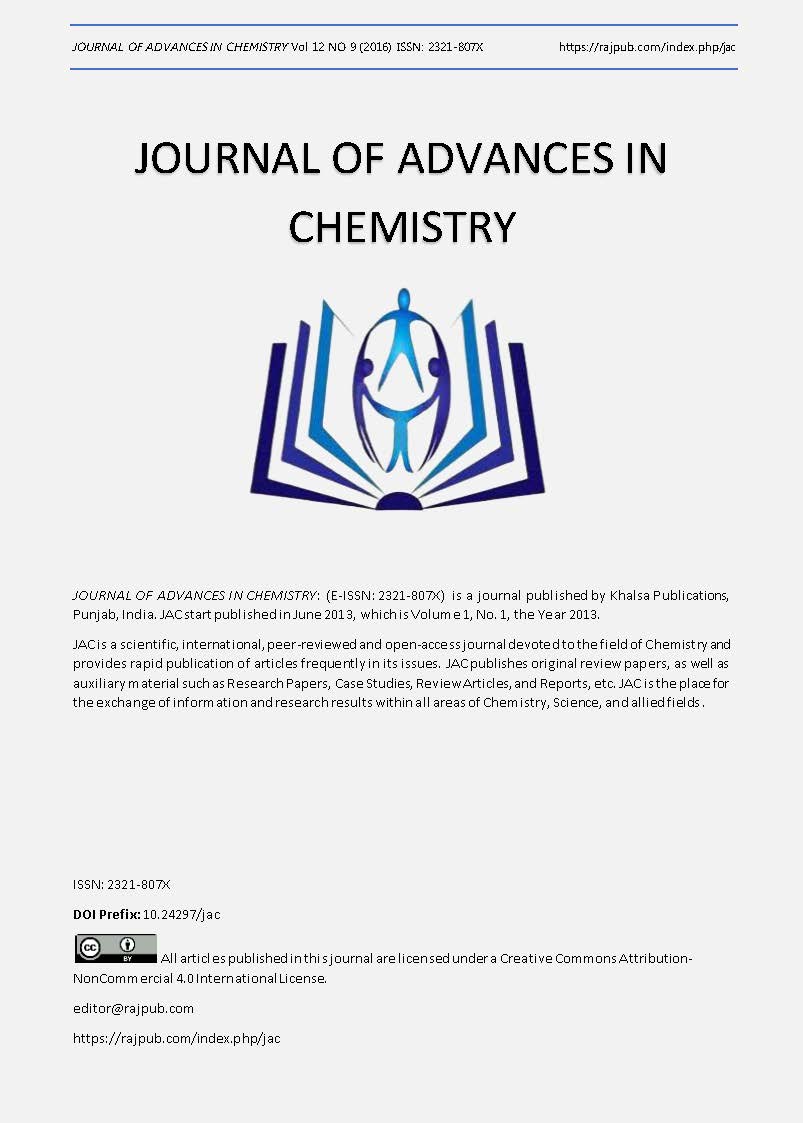OXIDATION OF BENZALDEHYDE BY QUINOXALINIUM DICHROMATE
DOI:
https://doi.org/10.24297/jac.v12i9.6707Keywords:
Oxidation, Kinetics, Mechanism, Benzaldehyde, Quinoxalinium dichromateAbstract
The kinetics and mechanism of oxidation of benzaldehyde by quinoxalinium dichromate has been studied in the presence of perchloric acid in 70 % acetic acid - water medium. The reaction follows first order with respect to benzaldehyde, quinoxalinium dichromate and fractional order with respect to perchloric acid. There is no effect on the reaction rate with increase in ionic strength of the medium by adding sodium perchlorate. The rate of reaction increases with increase in the percentage of acetic acid. The reaction does not induce the polymerization with acrylonitrile. The rate of reaction decreases with increase in the concentration of manganoussulphate. The thermodynamic and activation parameters have been calculated and a probable mechanism has been proposed.
Downloads
References
[2] Ozgun B and Degirmenbasi N, Monatshefte Fur Chemie, 133, (2004), 483.
[3] Sekar KG and Manikandan G, Oxid. Commun., 35(3), (2012), 577.
[4] Sekar KG and Manikandan G, Int. J. Ad. Pharm. Bio. & Chem., 1(4), (2012), 450.
[5] Sekar KG and Manikandan G, Der Chemica Sinica, 4(1), (2013), 100.
[6] Chowdhury SK and Banerji KK, J. Org. Chem., 56(17), (1991), 5111.
[7] Ramakrishnan PS and Chockalingam P, J. Indian Chem. Soc., 70, (1993), 581.
[8] Elango KP and Karunakaran K, Asian J. Chem., 7(4), (1995), 798.
[9] Elango KP and Karunakaran K, Oxid. Commun., 19(1), (1996), 50.
[10] Abdul Jameel A, J. Indian Chem. Soc., 75, (1998), 439.
[11] Mahanti MK, Oxid. Commun., 22(1), (1999), 142.
[12] Balasubramanian K, Lakshmanan K and Sekar KG, Asian J. Chem., 11(4), (1999), 1451.
[13] Sekar KG, J. Chem. Res.(S), (2002), 626.
[14] Fatimajeyanthi G and Elango KP, Int. J. Chem. Kinet., 35, (2003), 154.
[15] Panda R and Acharya PK, Indian J. Chem., 44A, (2005), 710.
[16] Sekar KG and Prabakaran A, Oxid. Commun., 31(3), (2008), 613.
[17] Krishnasamy K, Devanathan D and Dharmaraja J, Trans. Metal Chem., 32(7), (2007), 922.
[18] Sheik Mansoor S and Syed Shafi S, E-Journal of Chem., 6(S1), (2009), S522.
[19] Kanchan Kumar Rai, Ravi Kant Kannaujia, Karuna Rai and Surjeet Singh, Orient. J. Chem., 29(3), (2013), 1071.
[20] Amis ES, J. Am. Chem. Soc., 77, (1955), 4187.
[21] Amis ES, “Solvent Effects on Reaction Rates & Mechanismâ€, Academic Press, Newyork, (1966), 42.
[22] Priya V, Balasubramanian M and Mathiyalagan N, J. Chem. Pharm. Res., 3(1), (2011), 522.
Downloads
Published
How to Cite
Issue
Section
License
 All articles published in Journal of Advances in Linguistics are licensed under a Creative Commons Attribution 4.0 International License.
All articles published in Journal of Advances in Linguistics are licensed under a Creative Commons Attribution 4.0 International License.




